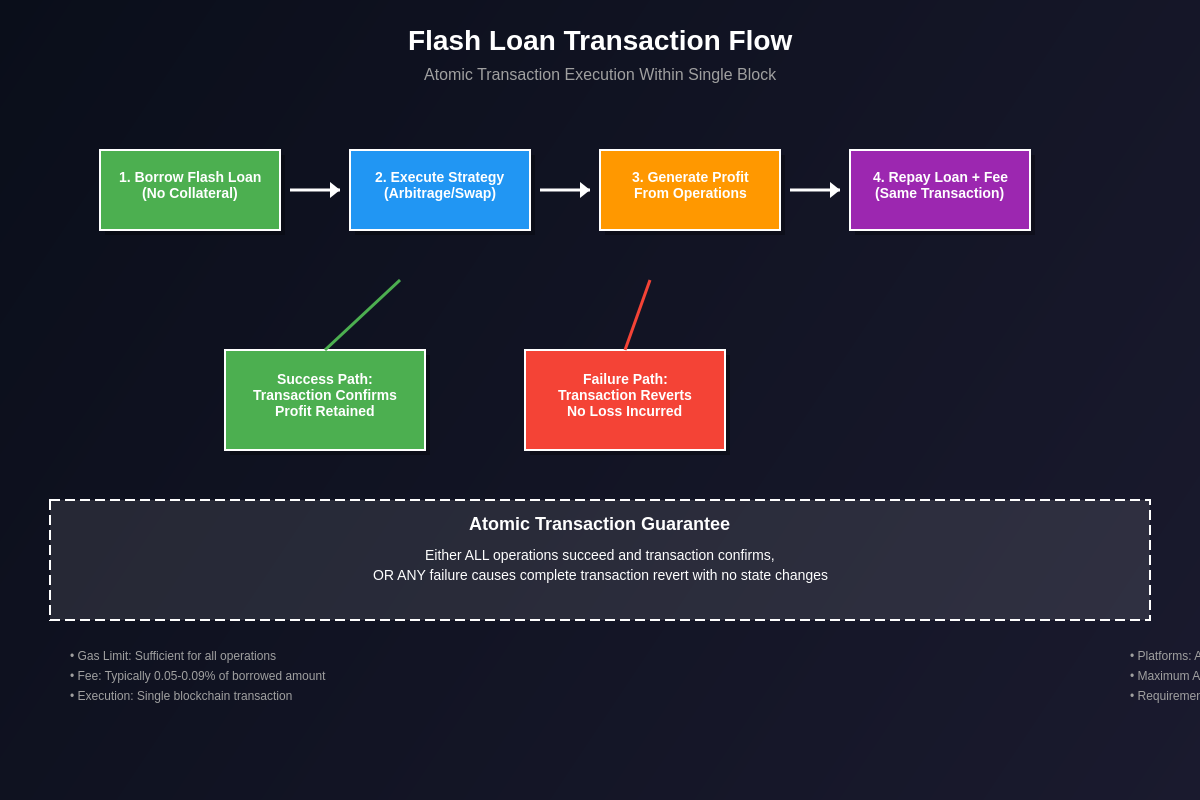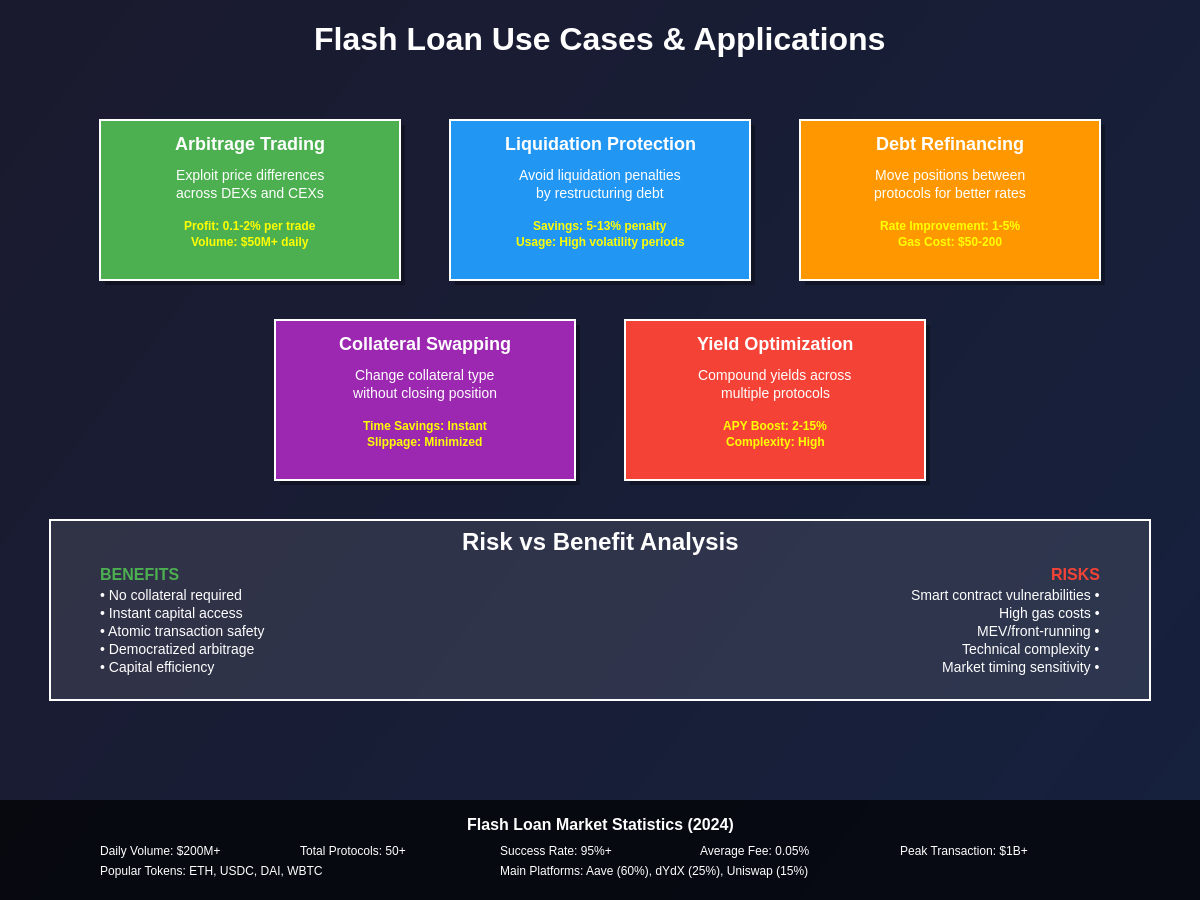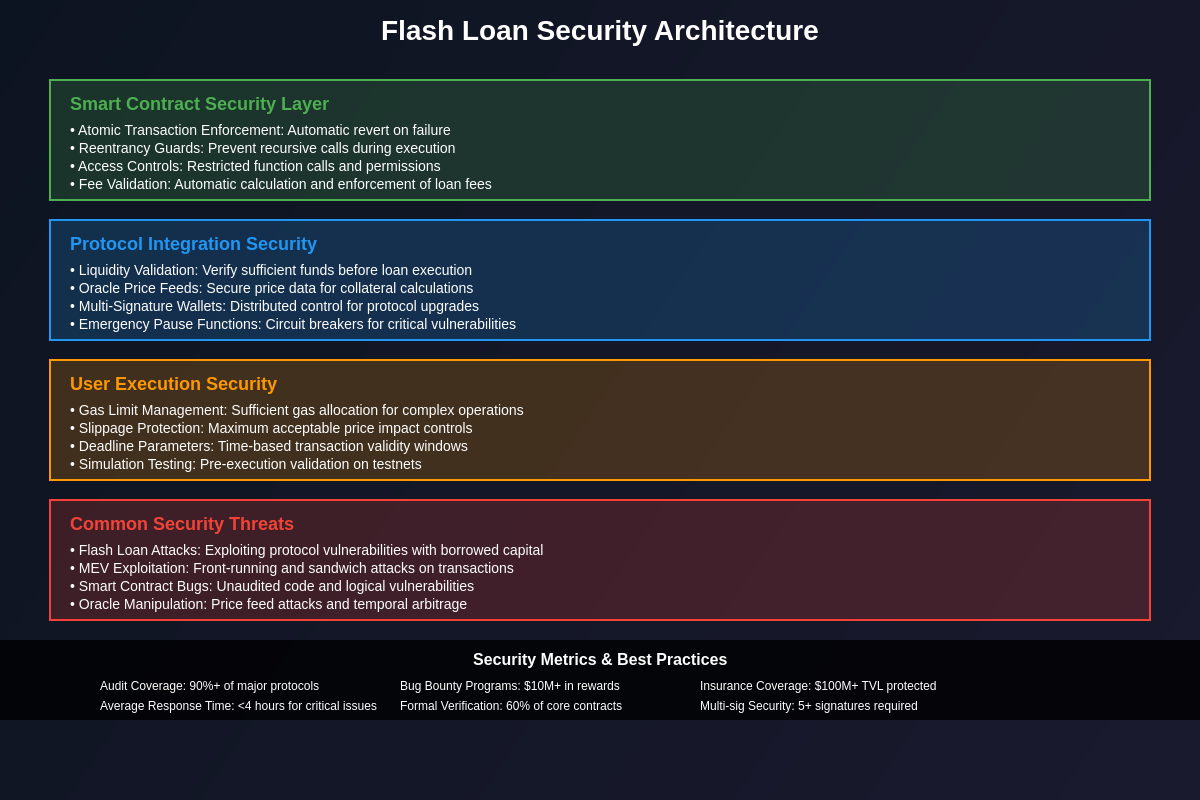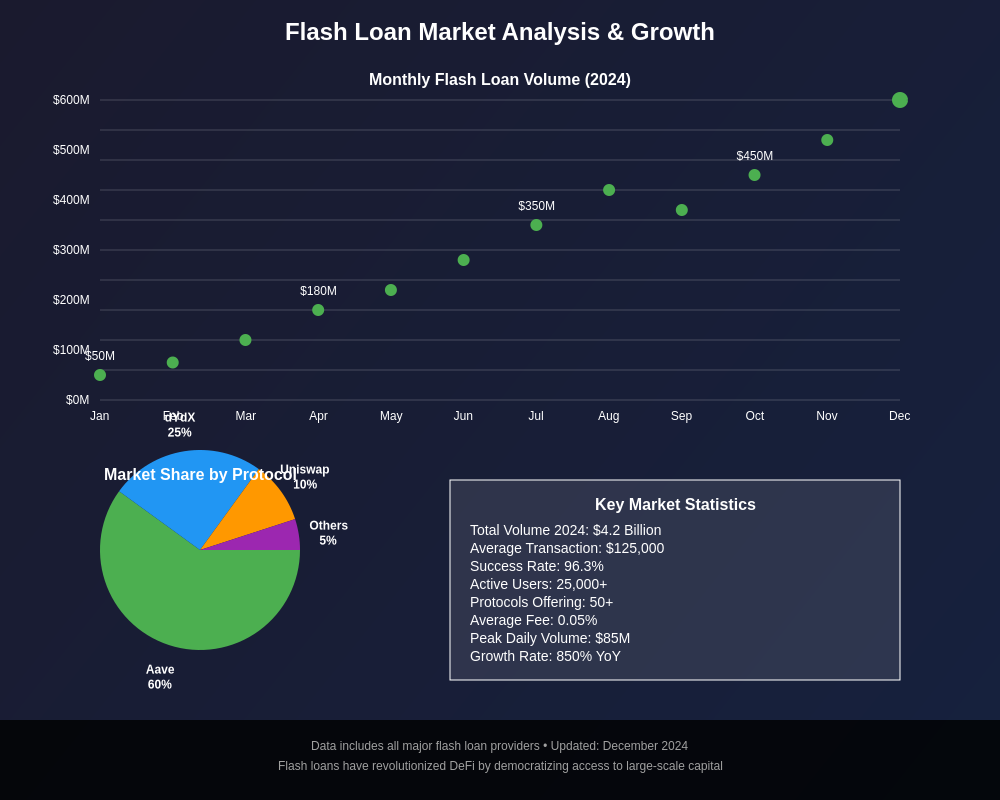For the latest insights on DeFi protocols and flash loan strategies, visit TradingView’s comprehensive market analysis tools that help traders understand complex DeFi mechanics and market movements.
Revolutionary Uncollateralized Lending in Decentralized Finance
Flash loans represent one of the most innovative and revolutionary concepts in decentralized finance, enabling users to borrow substantial amounts of cryptocurrency without providing any collateral, under the condition that the entire loan must be repaid within the same blockchain transaction. This groundbreaking financial primitive has transformed how traders, arbitrageurs, and developers interact with DeFi protocols, creating new opportunities for capital efficiency while simultaneously introducing novel risks and attack vectors that continue to shape the evolution of decentralized financial systems.
The fundamental principle underlying flash loans challenges traditional lending paradigms by leveraging the atomic nature of blockchain transactions, where either all operations within a transaction succeed or the entire transaction is reverted as if it never occurred. This unique characteristic allows lenders to provide uncollateralized loans with absolute certainty that they will be repaid, as any transaction that fails to repay the loan will automatically fail, ensuring the lender never loses their funds.

Technical Architecture and Implementation
The technical implementation of flash loans relies on sophisticated smart contract architecture that enforces loan repayment through transaction atomicity, ensuring that borrowers cannot access loaned funds without guaranteeing repayment within the same transaction block. Leading DeFi protocols have implemented various approaches to flash loan functionality, with platforms like Aave, dYdX, and Uniswap each offering unique features and fee structures designed to optimize different use cases and risk profiles.
Aave’s flash loan implementation represents one of the most widely adopted approaches, utilizing a pool-based lending model where users can borrow any available asset from the protocol’s liquidity pools without collateral, provided they repay the loan plus a small fee within the same transaction. The protocol’s smart contracts automatically check for loan repayment at the end of transaction execution, reverting the entire transaction if repayment requirements are not met, thus protecting lenders from default risk while enabling borrowers to access significant liquidity for complex DeFi operations.
The gas optimization considerations for flash loan implementations are particularly important given the complexity of operations that must be completed within a single transaction, with developers focusing on minimizing computational overhead while maintaining security and functionality. Advanced implementations incorporate features like batch operations, dynamic fee calculations, and integration with multiple liquidity sources to enhance capital efficiency and reduce costs for users executing complex trading strategies.
Flash loan contracts typically implement callback functions that allow borrowers to execute custom logic during the loan period, enabling sophisticated strategies that combine multiple DeFi protocols and operations. These callback mechanisms must be carefully designed to prevent reentrancy attacks and other security vulnerabilities while providing sufficient flexibility for legitimate use cases ranging from arbitrage trading to debt restructuring and liquidation protection.
Arbitrage Opportunities and Market Efficiency
Flash loans have revolutionized arbitrage trading in decentralized finance by eliminating capital requirements for exploiting price discrepancies across different trading venues, enabling traders to profit from market inefficiencies without risking their own funds. This democratization of arbitrage opportunities has contributed to improved price discovery and market efficiency across DeFi protocols, as the increased arbitrage activity helps align prices across different platforms and reduces the persistence of profitable price gaps.
Professional arbitrageurs utilize flash loans to execute complex multi-step trading strategies that capitalize on price differences between centralized and decentralized exchanges, cross-chain price discrepancies, and temporary imbalances in automated market maker pools. These strategies often involve borrowing large amounts of cryptocurrency, executing trades across multiple platforms to exploit price differences, and repaying the loan with the profits generated from the arbitrage operation, all within a single transaction.

The sophistication of flash loan arbitrage strategies has evolved significantly, with traders developing automated systems that monitor hundreds of trading pairs across dozens of platforms to identify and execute profitable opportunities within seconds of their emergence. These systems must account for gas costs, slippage, protocol fees, and competition from other arbitrageurs to ensure profitability, requiring advanced algorithms and real-time market data analysis to remain competitive in the rapidly evolving DeFi landscape.
When analyzing market opportunities across different platforms, traders often rely on TradingView’s advanced charting capabilities to identify price discrepancies and develop profitable arbitrage strategies using flash loan mechanisms.
Statistical arbitrage strategies utilizing flash loans have become increasingly sophisticated, incorporating machine learning algorithms and quantitative models to identify subtle price patterns and correlations that can be exploited through rapid execution of complex trading operations. These strategies often combine traditional arbitrage with more advanced techniques like statistical pair trading, momentum-based strategies, and volatility arbitrage to generate consistent returns across different market conditions.
Liquidation and Debt Management Applications
Flash loans have become essential tools for debt management and liquidation operations in DeFi protocols, enabling users to restructure their positions, avoid liquidations, and optimize their capital allocation without requiring additional collateral or capital. These applications demonstrate the practical utility of flash loans beyond speculative trading, showing how uncollateralized lending can solve real financial problems and improve capital efficiency for DeFi users.
Liquidation protection strategies using flash loans allow borrowers to avoid forced liquidations by temporarily borrowing funds to repay their debts, swapping collateral to more stable assets, or restructuring their positions across different protocols with better terms. These strategies can save users significant amounts in liquidation penalties while enabling them to maintain their long-term investment positions during periods of market volatility or temporary financial constraints.
Debt consolidation applications enable users to combine multiple loans across different DeFi protocols into a single position with better terms, lower interest rates, or improved collateral efficiency. Flash loans facilitate these operations by providing the temporary liquidity needed to repay existing debts and establish new positions without requiring users to maintain sufficient capital to cover all debts simultaneously.
Collateral swapping represents another important application where users employ flash loans to change their collateral composition without closing and reopening their entire position, enabling them to optimize for better loan-to-value ratios, reduced liquidation risk, or improved yield opportunities. These operations are particularly valuable during periods of market volatility when users need to quickly adjust their risk exposure without incurring the costs and slippage associated with traditional position management methods.
Protocol Integration and Composability
The composability of flash loans with other DeFi protocols has created a rich ecosystem of interconnected financial services that can be combined in novel ways to create sophisticated financial products and strategies. This composability is fundamental to the value proposition of decentralized finance, as it enables developers and users to combine simple building blocks into complex financial operations that would be impossible or prohibitively expensive in traditional financial systems.
Integration with automated market makers enables flash loan users to execute large trades with minimal slippage by utilizing the deep liquidity available across multiple AMM pools, often combining trades across different protocols to achieve better execution prices than would be available on any single platform. These integrations require careful consideration of price impact, fee structures, and liquidity availability to ensure optimal execution and profitability.
Yield farming optimization strategies frequently incorporate flash loans to maximize returns by enabling users to quickly move capital between different protocols based on changing yield opportunities, compound rewards across multiple platforms, or execute complex strategies that combine lending, borrowing, and trading operations. These strategies often involve automated execution systems that continuously monitor yield opportunities and execute rebalancing operations using flash loans to maintain optimal capital allocation.
Governance token acquisition strategies utilizing flash loans have emerged as a controversial but technically fascinating application, where users temporarily borrow large amounts of assets to acquire governance tokens for voting purposes, potentially influencing protocol decisions before repaying the loans. While some protocols have implemented safeguards against this practice, it highlights the broader implications of flash loans for decentralized governance systems.
Risk Factors and Security Considerations
Despite their innovative design and useful applications, flash loans introduce significant risks and security considerations that users and developers must carefully evaluate before implementing flash loan strategies or integrating flash loan functionality into their protocols. The complexity of flash loan operations, combined with the atomic transaction requirement, creates numerous potential failure points that can result in financial losses or security vulnerabilities.
Smart contract risk represents one of the most significant concerns for flash loan users, as the complex interactions between multiple protocols within a single transaction create numerous opportunities for bugs, exploits, or unexpected behavior. Users must trust not only the flash loan provider but also all intermediate protocols and contracts involved in their strategy, creating a compound risk that increases with the complexity of the operation.

The technical complexity of implementing successful flash loan strategies requires significant expertise in smart contract development, DeFi protocol mechanics, and risk management, making these tools primarily accessible to sophisticated users and developers rather than retail participants. This complexity barrier can lead to mistakes and losses for inexperienced users who attempt to implement flash loan strategies without fully understanding the technical requirements and risk factors involved.
Market risk remains a significant factor in flash loan operations, as strategies that depend on specific price relationships or market conditions can become unprofitable or impossible to execute due to rapid market movements, changes in protocol parameters, or increased competition from other arbitrageurs. The atomic nature of flash loans means that unsuccessful strategies result in complete transaction failure and loss of gas fees, making risk assessment and strategy validation crucial for profitable operations.
Front-running and MEV (Maximal Extractable Value) considerations have become increasingly important as flash loan strategies often involve predictable and profitable operations that can be copied or exploited by MEV searchers and automated bots. Users must consider these competitive dynamics when developing flash loan strategies and may need to implement additional protections or use specialized transaction pools to prevent exploitation.
Economic Impact and Market Dynamics
The introduction and widespread adoption of flash loans has had profound effects on DeFi market dynamics, contributing to improved capital efficiency, enhanced arbitrage activity, and increased interconnectedness between different protocols and markets. These changes have generally resulted in more efficient price discovery and reduced arbitrage opportunities, while also creating new forms of systemic risk and market manipulation potential.
Capital efficiency improvements from flash loans benefit the entire DeFi ecosystem by enabling more effective use of available liquidity, reducing the amount of idle capital required for various operations, and enabling smaller participants to compete with well-capitalized institutions in arbitrage and trading activities. This democratization of access to large amounts of capital has contributed to more competitive and efficient markets while reducing barriers to entry for sophisticated trading strategies.
The impact on traditional arbitrage markets has been significant, with flash loans enabling much faster exploitation of price discrepancies and reducing the duration and magnitude of arbitrage opportunities across different trading venues. While this has improved overall market efficiency, it has also increased the technical sophistication required to identify and exploit profitable opportunities, leading to a more competitive and rapidly evolving arbitrage landscape.

For comprehensive analysis of how flash loans impact market dynamics and price movements, traders can utilize TradingView’s professional-grade analytical tools to understand the complex relationships between DeFi protocols and traditional cryptocurrency markets.
Systemic risk considerations have become increasingly important as flash loans enable rapid and large-scale movement of capital across different protocols, potentially amplifying market volatility and creating cascading effects during periods of market stress. Regulatory authorities and protocol developers are increasingly focused on understanding and mitigating these risks while preserving the benefits of flash loan functionality.
Regulatory Perspectives and Compliance Challenges
The regulatory landscape surrounding flash loans remains largely undefined, with traditional financial regulatory frameworks struggling to categorize and address the unique characteristics of uncollateralized, atomic lending transactions. This regulatory uncertainty creates challenges for both flash loan providers and users, who must navigate evolving compliance requirements while maintaining the innovative functionality that makes flash loans valuable.
The instantaneous nature of flash loans challenges traditional concepts of lending, borrowing, and financial intermediation, raising questions about how existing regulatory frameworks should apply to these novel financial instruments. Regulators must balance the need to protect consumers and maintain financial stability with the desire to support innovation and the development of new financial technologies that could provide significant benefits to market participants.
Anti-money laundering (AML) and know-your-customer (KYC) requirements present particular challenges for flash loan operations, as the rapid, automated nature of these transactions makes traditional compliance monitoring difficult while the pseudonymous nature of blockchain transactions complicates identity verification and transaction tracking. Protocol developers and service providers must develop new approaches to compliance monitoring that can operate effectively in the DeFi environment.
Cross-border regulatory coordination will likely become increasingly important as flash loan usage grows and these operations increasingly involve multiple jurisdictions, different regulatory frameworks, and various types of digital assets. The global nature of DeFi protocols and the ease with which flash loans can be used across different markets creates challenges for traditional territorially-based regulatory approaches.
Future Developments and Innovation Trends
The future evolution of flash loans is likely to be driven by improvements in scalability, cross-chain functionality, enhanced security features, and broader integration with both DeFi and traditional financial systems. These developments will expand the utility and accessibility of flash loans while addressing current limitations and risk factors that constrain their broader adoption.
Layer 2 scaling solutions and alternative blockchain platforms are beginning to offer flash loan functionality with significantly reduced gas costs and faster execution times, making these tools accessible to a broader range of users and enabling more frequent execution of smaller-scale strategies. These scalability improvements are particularly important for retail users and smaller-scale operations that were previously excluded from flash loan strategies due to high transaction costs.
Cross-chain flash loans represent an emerging area of development that could significantly expand the utility and market impact of uncollateralized lending by enabling arbitrage and other strategies across different blockchain networks. These implementations face significant technical challenges related to atomic execution across different blockchain protocols, but successful solutions could create new categories of cross-chain financial strategies and improve overall market efficiency across the broader cryptocurrency ecosystem.
Integration with traditional financial systems through central bank digital currencies (CBDCs), stablecoins, and regulated DeFi platforms could bring flash loan functionality to mainstream financial markets, potentially revolutionizing how institutional arbitrage, market making, and liquidity provision operate. However, such integration would likely require significant modifications to current flash loan implementations to meet regulatory requirements and traditional financial system standards.
Machine learning and artificial intelligence applications in flash loan strategy development are becoming increasingly sophisticated, with automated systems capable of identifying, evaluating, and executing complex arbitrage opportunities across multiple protocols and markets. These developments could further democratize access to sophisticated trading strategies while increasing the overall efficiency and competitiveness of DeFi markets.
Educational Resources and Getting Started
Understanding flash loans requires a solid foundation in blockchain technology, smart contract development, and DeFi protocol mechanics, making education and skill development crucial for anyone seeking to utilize these powerful financial tools effectively. The complexity of flash loan operations means that thorough preparation and understanding are essential for avoiding costly mistakes and maximizing the potential benefits of uncollateralized lending.
Technical prerequisites for flash loan development include proficiency in Solidity programming, understanding of Ethereum Virtual Machine (EVM) mechanics, familiarity with popular DeFi protocols and their APIs, and knowledge of gas optimization techniques. Developers should also understand security best practices, common attack vectors, and testing methodologies specific to complex DeFi operations involving multiple protocol interactions.
Practical learning approaches often involve starting with simple arbitrage strategies using testnet implementations before progressing to more complex operations on mainnet, allowing developers to gain experience with flash loan mechanics without risking significant capital. Many educational platforms and DeFi protocols provide tutorial materials, code examples, and sandbox environments specifically designed for learning flash loan development and implementation.
Risk management education is particularly important given the complexity and potential consequences of flash loan operations, with users needing to understand not only the technical aspects of implementation but also the market risks, protocol risks, and competitive dynamics that can affect strategy profitability and safety. Comprehensive risk assessment frameworks and testing methodologies are essential skills for successful flash loan utilization.
Community resources including developer forums, Discord channels, educational content creators, and open-source code repositories provide valuable learning opportunities and support networks for those developing flash loan expertise. These communities often share strategies, discuss technical challenges, and provide feedback on new implementations, making them valuable resources for both beginners and experienced practitioners.
Disclaimer: This article is for educational purposes only and does not constitute financial advice. Flash loans involve significant technical and financial risks. Cryptocurrency investments and DeFi strategies carry substantial risk of loss. Always conduct thorough research and consider consulting with qualified professionals before engaging in flash loan strategies or other DeFi activities. Past performance does not guarantee future results.